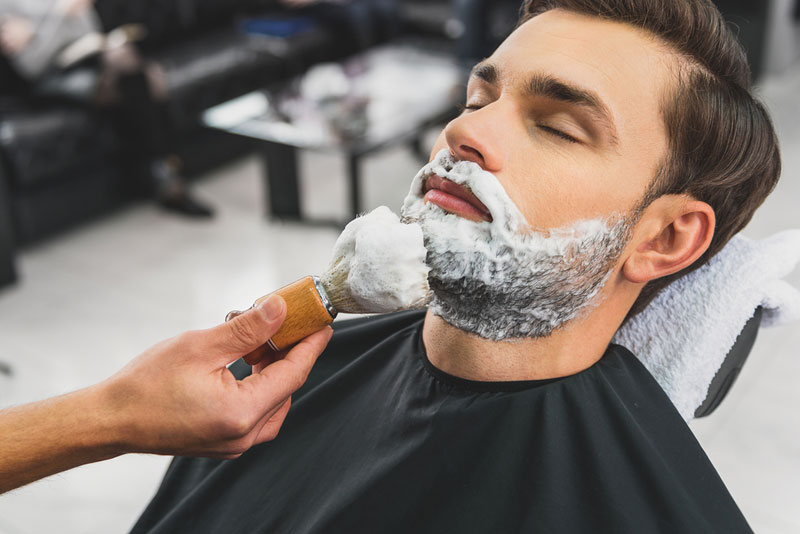The Strange History of Anthrax Cases Tied to Men's Shaving Brushes

Old-fashioned shaving tools are getting trendy with younger men these days, but one such tool has an interesting history: Men's shaving brushes made from animal hair were linked with cases of anthrax around the time of World War I, according to a new report.
The report describes several hundred cases of anthrax, which occurred from 1915 to 1924, were tied to shaving brushes, mainly among men in the U.S. military. Shaving brushes are small facial brushes that are used to apply shaving cream or soap. They were invented in the 18th century.
In 1921, researchers in New York City tested shaving brushes purchased from street vendors, and they found Bacillus anthracis, the bacteria that causes anthrax, in 78 percent of the brushes, the new report said.
Although the risk of contracting anthrax today from an animal-hair shaving brush is extremely low, the report "serves to remind those interested in a return to 'natural grooming' that use of untreated hair from horses, pigs, badgers, or other animals" poses a potential risk of getting anthrax spores into openings on the skin, the researchers said. [10 Deadly Diseases That Hopped Across Species]
Traditionally, the brushes were made with hair from badgers, horses or boars, although badger hairbrushes were the most popular, the researchers said. In recent years, shaving brushes have made something of a comeback as part of a growing niche market of vintage shaving tools, according to the Los Angeles Times.
Given the renewed interested in shaving brushes, the researchers, from the Centers for Disease Control and Prevention, thought it was relevant to review information on cases of anthrax linked to these brushes.
In the new report, the CDC researchers reviewed summaries of disease outbreaks and medical case reports. The outbreak summaries from 1915 to 1924 came from Europe and the United States, and the researchers found 149 cases of anthrax linked to shaving brushes among members of the U.S. military; 17 cases among American civilians; 28 cases among members of the British military; and 50 cases among British civilians.
Sign up for the Live Science daily newsletter now
Get the world’s most fascinating discoveries delivered straight to your inbox.
From the medical case reports, which were published from 1880 to 2013, the CDC researchers also found 43 cases of anthrax linked to shaving brushes. All but two of the cases occurred between 1917 and 1923, and 84 percent of the patients were Americans. Of the two most "recent" cases, one was from 1935, involving a man in Trinidad, and the other involved a man living in India in 1989.
The cause of the "mini epidemic" of anthrax cases appears to have been related to the disruption of commerce during World War I, the researchers said. Prior to the war, badger hair for the brushes was sourced from Russia, but this hair became difficult to acquire during the war. As a consequence, horsehair was used to make imitation badger brushes.
However, before the war, the animal hair had been disinfected in France or Germany before it was sent to the U.S. While the war was underway, the hair was shipped directly to the U.S. from Russia, China or Japan, the researchers said.
Public health officials who investigated the anthrax outbreaks at the time speculated that some manufacturers used the horsehair as received, because they assumed it was already disinfected.
In addition, some manufacturers may have avoided disinfecting lighter-colored hairbrushes because the high-temperature treatment might have discolored the brushes and reduced their resemblance to badger hair, the researchers said. Lighter-colored brushes were more likely to be linked to cases of anthrax compared to dark-colored brushes, they noted.
The connection to horsehair is not surprising, the researchers said. Studies have found that horses are more susceptible to anthrax than badgers and pigs. So, it's even possible that the hair used in these brushes was taken from horses that died from anthrax, they said.
Today, animal-hair shaving brushes are unlikely to be a source of anthrax because of modern decontamination processes and regulations on imports, the researchers said. Even the risk from used, vintage brushes would be extremely low, they said. However, the anthrax cases linked to shaving brushes usually involved new brushes, and so shavers buying unused vintage brushes from the early 20th century might want to consider this small risk before using them for shaving, they said. [5 Deadly Diseases Emerging from Global Warming]
"This historical information is relevant to current public health practice because renewed interest in vintage and animal-hair shaving brushes has been seen in popular culture," the researchers wrote in the May issue of the journal Emerging Infectious Diseases. "This information should help healthcare providers and public health officials answer questions on this topic."
The researchers do not recommend trying to disinfect vintage brushes at home because the risks of this process — which involves using steam, pressure and formaldehyde — are likely to outweigh the benefits, they said.
Original article on Live Science.

Rachael is a Live Science contributor, and was a former channel editor and senior writer for Live Science between 2010 and 2022. She has a master's degree in journalism from New York University's Science, Health and Environmental Reporting Program. She also holds a B.S. in molecular biology and an M.S. in biology from the University of California, San Diego. Her work has appeared in Scienceline, The Washington Post and Scientific American.









